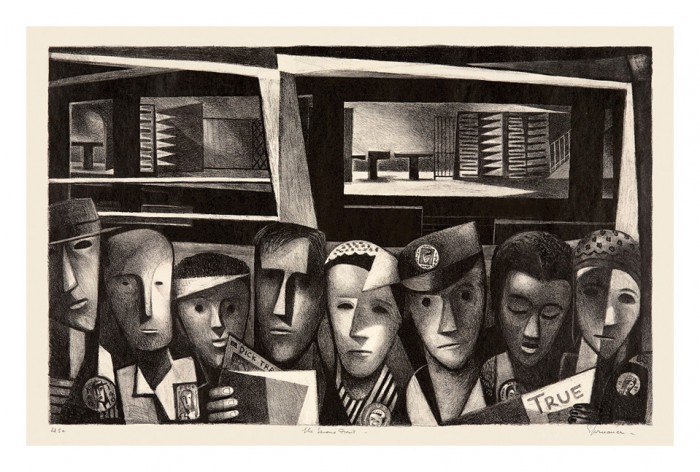Subway Shift; The Second Front
 Benton Spruance (1904-1967), Subway Shift; The Second Front , 1943, Lithograph.
Benton Spruance (1904-1967), Subway Shift; The Second Front , 1943, Lithograph.
Fine and Looney 223. Edition: 30; signed, titled and annotated Ed 30 in pencil. Initialed in the stone, lower right.
Image size 10 3/16 x 16 1/4 inches (368 x 486 mm); sheet size 15 1/4 x 23 1/8 inches (387 x 587 mm).
A fine, rich impression, on cream wove paper with a Signature watermark, with full margins, in excellent condition. Printed by Cuno.
Subway Shift has of course been reproduced widely, including recently in The American Scene: Prints from Hopper to Pollock, Stephen Coppel, The British Museum, 2008, reproduced p. 205. In this publication Coppel points out that Spruance made Subway Shift as part of a “government-sponsored Artists for Victory initiative inspired by artists all over America to take up the patriotic call,” and that Subway Shift portrayed “civilians who have signed up for the home front as politically engaged citizens” (p. 30).
But my colleague Keith Sheridan points out that a close reading of the print shows its meaning to be quite different from a simple-minded “patriotic call.” Indeed, Spruance was a socially conscious and thoughtful artist who surely had reservations about war as an instrument of policy, and probably also wondered about the unswerving allegiance of average citizens to the cause, . Focusing on the print itself, Sheridan points out that six of the subway riders are wearing pins, which might have expressed patriotic positions, but in fact are pictures of themselves! And instead of reading “politically engaging” newspapers or journals, one is reading a Dick Tracey comic book, another a True Romances magazine. So the members of this Second Front would appear to be engaged far more with themselves and their frivolous pursuits than with serious matters of the War.